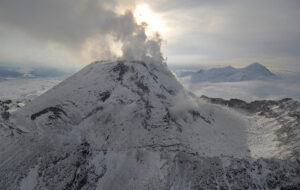Two volcanoes on Mars, Olympus Mons and Alba Mons, were islands in the past, scientists now believe. The shapes of both mountains resemble volcanic islands here on Earth. They could have formed in an ocean that used to exist on the red planet.
Olympus Mons lies in Mars’s northern hemisphere and is the largest mountain in the entire solar system. It is over 25,000m high and 601km wide. Its summit is 3km wide and 80km long.
To put its ginormous size into perspective, it is three times higher than Mount Everest, 100 times larger than Mauna Lo, the tallest volcano on Earth, and approximately the size of France.

A 3D image of Olympus Mons. Photo: NASA
Much wider than it is high
A six-kilometer-high flat escarpment surrounds the volcano. This suggests that it is a shield volcano. It is wider than it is tall and — despite its mega-height — has a comparatively low profile. We first learned about it in 1971 through images from Mariner 9, the first spacecraft to orbit Mars. Since its discovery, scientists have wondered how the volcano formed.
France’s National Center for Scientific Research (CNRS) has a new study that concludes that it was created by lava flowing into a body of liquid water. This would mean that the giant volcano was previously an active volcanic island.
The team analyzed data from the Mars Orbiter Laser Altimeter and satellite images of the volcano. They then compared it to field studies from volcanic islands here on Earth. They found similarities with islands in the Azores, Hawai, the Galapagos, Cape Verde, and the Canary Islands. This would mean that the top of the six-kilometer-high high slopes is an ancient shoreline.

A volcanic island in the middle of a vanished Martian ocean. Photo:Anthony Hildenbrand/Geops/CNRS
Evidence is building for the existence of a past ocean on Mars. Martian rovers from America and China have both found evidence of water. Earlier this year, China’s Zhuring rover discovered marine sedimentary rocks in the northern lowlands of the planet, where Olympus Mons lies.
Determining the age of Olympus Mons could help us better understand what happened to the water on Mars.
Alba Mons, a much smaller volcano 1,800km away from Olympus Mons, shows similar features. The researchers believe it also used to be a volcanic island, although a smaller one.






